Santa Ana | |
|---|---|
 From the top, left to right: The Saint Anne parish church, a Roble Sabana, the Escazú mountains as seen from the Salitral district, the Santa Ana Conservation Centre, a shopping centre, a view of the sunset in the Piedades district, a view of Santa Ana at night. | |
 Flag 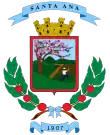 Seal | |
| Nicknames: Valle del Sol [1] Spanish for: "Valley of the Sun" | |
Santa Ana canton | |
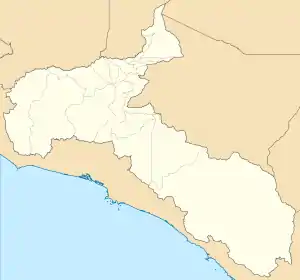 Santa Ana Santa Ana canton location in San José Province 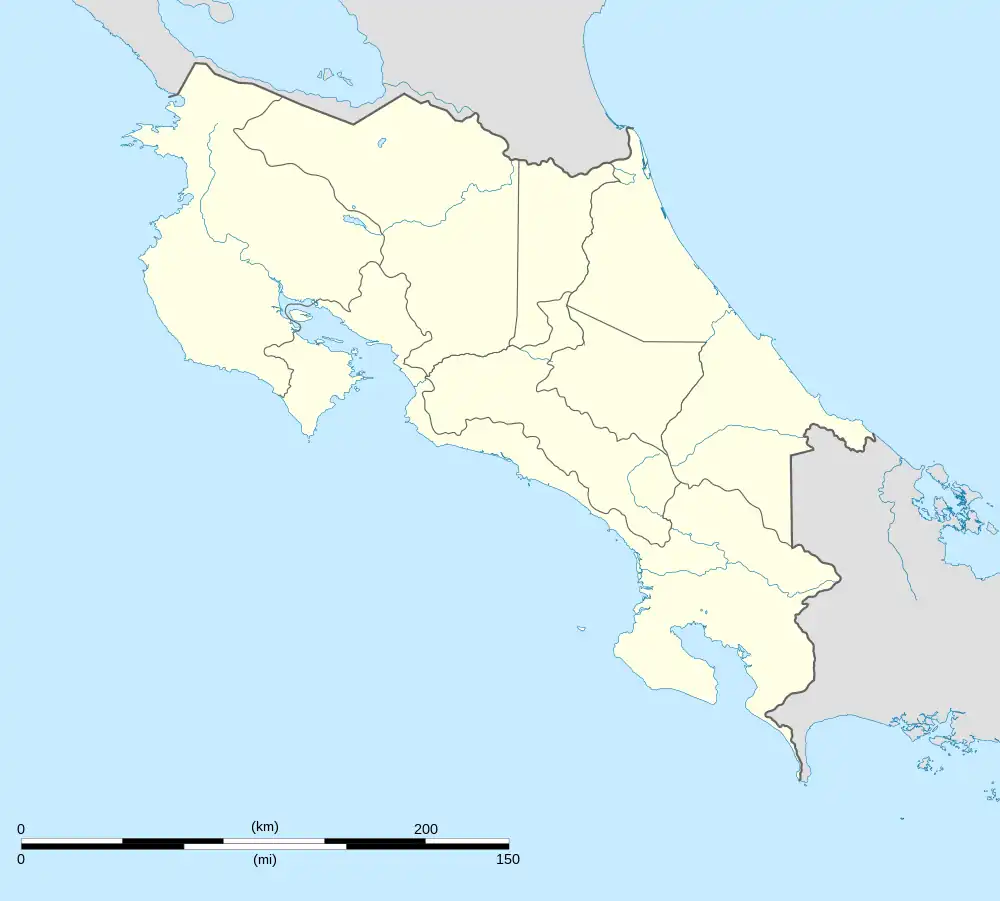 Santa Ana Santa Ana canton location in Costa Rica | |
| Coordinates: 9°55′06″N 84°11′45″W / 9.9184253°N 84.1957531°W | |
| Country | |
| Province | San José |
| Creation | 29 August 1907[2] |
| Head city | Santa Ana |
| Districts | |
| Government | |
| • Type | Municipality |
| • Body | Municipalidad de Santa Ana |
| • Mayor | Gerardo Oviedo Espinoza (PLN) |
| Area | |
| • Total | 61.42 km2 (23.71 sq mi) |
| Elevation | 904 m (2,966 ft) |
| Population (2011) | |
| • Total | 49,123 |
| • Density | 800/km2 (2,100/sq mi) |
| Demonym(s) | Santaneño, -a |
| Time zone | UTC−06:00 |
| Canton code | 109 |
| Website | www |
Santa Ana is the ninth canton in the San José province of Costa Rica.[3][4] It is located in the Central Valley. It borders with the Alajuela canton to the north, the Mora canton to the south and west, the Escazú canton to the east, as well as the Belén canton to the north east.[5] As of 2020, the canton has the highest Human Development Index of any region in Costa Rica with a HDI of 0.871.[6]
Toponymy
The first mention of the name appears in the Protocols of Cartago on December 1, 1658, when part of the land which now conforms the canton became property of José de Alvarado and Petronilla de Retes after their marriage. The name of the lands comes from the original owner, Jerónimo de Retes y López de Ortega, father of Petronilla. Ortega was seeded the land in the 17th century by the Spanish crown as recognition for his work as an official in Cartago. It is theorised that the lands were named in honour of Saint Anne, possibly because Ortega had a special affinity with the saint (as he would later name his daughter Ana de Retes after the saint as well).[7][8][9]
History
Precolombian and Early History
The earliest known occupied settlements in the region can be dated to the 3rd century, with the land that now conforms the canton being part of the indigenous Reino Huetar de Occidente ( "The Huetar Kingdom of the West" ). At the time of the Spanish's arrival in the 16th century, this kingdom was one of two indigenous kingdoms ruled by the cacique Garabito.[1] A total of 11 archaeological sites can be found in the canton.[10]
After Christopher Columbus' arrival on the Costa Rican coast in 1502, the Spanish made few expeditions into the region, with no permanent Spanish settlement existing in the region for nearly 60 years following Columbus' arrival.[9][11] However in 1559, upon receiving a royal license from Philip II of Spain, the governor of Nicaragua, Juan de Cavallón y Arboleda, planned an effort to colonise the Costa Rican Caribbean coast. Although this effort failed, in January 1561, alongside an expedition formed by 80 spaniards, slaves and a large amount of livestock, Cavallón entered the region from Nicaragua, in another effort to settle and pacify the region.[9][11] The expedition would pass near the modern-day location of Puntarenas, before marching further inland. There, Cavallón would send out various hunting parties, one of which captured an indigenous Chorotega chief called Coyote. Subsequently, Coyote's subjects agreed to guide Cavallón further inland.[9] From here, it is likely that the expedition followed the Central Valley's ridgelines, passing by the modern day location of Santiago de Puriscal, before entering the Santa Ana Valley.[7][9]
There, it is believed that Cavallón founded the settlement of Castillo de Garcimuñoz, which was named after his birthplace. It is believed to be the first permanent Spanish settlement in the region, aswell as the first Spanish settlement in the Central Valley.[7][9][11] However, the location of settlement has been debated, with some suggesting the location was further east, near modern day Desamparados.[9] In 1562 however, Cavallón would leave the settlement,[9] possibly discouraged by the lack of gold deposits in the region. He was replaced by veteran explorer Juan Vázquez de Coronado.[11] By 1563, the settlement was mostly abandoned, with many inhabitants (including Coronado) moving further east, where Coronado would eventually found the city of Cartago.[9][11] This was possibly done due to resistance from local tribes or possibly due to the lack of slave labour.[9] Following Cavallón's settlement, another expedition led by Don Antonio de Pereira would reach as far as the Santa Ana mountains, a region now known as "El Alto de las Palomas" ( "The Pigeon's Height" ).[7]
The canton was further colonised in the 16th or 17th century,[lower-greek 1] following the ceding of the land by the Spanish crown to Jerónimo de Retes y López de Ortega, the high sheriff of Cartago.[7][9] These lands were ceded as recognition for his work.[7] Following Jerónimo’s daughter (Petronila de Retes)’s marriage to José de Alvarado, part of the lands were ceded into the couple’s possession in a letter in the Protocols of Cartago dated on the 1 December, 1658. This letter also marks the first mention of the name Santa Ana, as a name for the lands.[7][9] Soon afterwards however, the lands would pass down to Ana de Retes, Petronilla’s sister.[9] Ana would later sell the lands in which the modern head city of Santa Ana is located in.[7]
The Retes family would later sell part of the lands in 1750 to a priest named Juan de Pomar y Burgos.[9] Around the year 1765, Pomar would build a house, (now known as "La Casona")[12] as-well as a chapel.[9][13] The Casona is still standing today, and is now part of the Museo Histórico Agrícola ( "Historical Agricultural Museum" ) located in the Santa Ana Conservation Centre. La Casona was also declared Historical Arquitectural Heritage of Costa Rica. It is one of the oldest structures located at the Conservation Centre.[12][13]
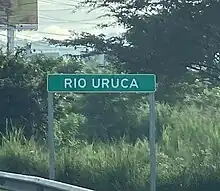
By 1817, most of the land had come into possession of Ana María de Cárdenas.[7] However, by 1850, the lands had changed hands multiple times, eventually ending up in the hands of a priest named Ana Tiburcio Fernández Valverde. Valverde would subsequently remodel the old chapel, converting it into a small hermitage, which would open in 1850.[7][9] Around this time, the modern day head city of the canton (Santa Ana) began to arise around the Fernández property, along the Uruca river. In March 1870, the current parish church of Santa Ana began construction, with it being completed in 1880. The centre of the future district moved east around this time to the location of the new parish church.[9][14][15]
In 1870 the mayoral office of Santa Ana is established, with Cerlindo Villarreal serving as the town first mayor. The town only had 1.068 residents at the time.[14] In 1890, a piece of former Fernández property, known as "Hacienda Ross" (named after its original owner, englishman Robert Ross Lang), is believed to have become the first ever Costa Rican settlement for railway workers, due to the good relationship between the railroad builder, Minor Kieth, and the Ross family.[9]
Independence From Escazu and Modern History
On the 29 of August 1907, under law no.8, Santa Ana was awarded the title of canton, becoming fully independent from Escazú. The first session of the new council was held on the 15th of September that same year.

In 1908, a contract was signed to build Costa Rica's second hydroelectric plant in the Brasil district of the canton, with it being finished it 1912. Electric streetlights would arrive the following year.[9] Around 1915, it is believed that onions were introduced to the canton, they would quickly become Santa Ana's most famous crop, with Santa Ana citizens being given the nickname of "Cebolleros" (onion farmers). Santa Ana holds an Onion fair even in modern times.[9][16] After the military coup of Federico Tinoco Granados in 1917, Santa Ana would become a mayor stronghold for rebellion against the government. Among the leaders of this rebellion was Jorge Volio Jiménez, a priest who was later honoured with a head bust outside of the Municipal Building of Santa Ana. Jimenez's rule would only lasted 2 years, with him being deposed in 1919. Costa Rica's first international airport would open in the canton, in the barrio of Lindora, in 1931, with the town soon being modernised into an international gateway for the country around 1934. The country's main airport would be moved to La Sabana in 1940.[9]
During the 1948 Costa Rican Civil War, the canton would be home to Marcial Aguiluz Orellana, a leading figure in the National Libertation Army during the civil war. He would later help defeat a counter-revolutionary movement by Rafael Angel Calderón Guardia in 1955, and would eventually join the Legislative Assembly of Costa Rica. He would die in the canton in 1986. The first automatic telephone would arrive in the canton in 1966.[9] On the 4 May 1970, Santa Ana was officially declared a city under the municipal code, and would become the seat for the Santa Ana canton.[7][9]
In 1971, the name of "Valley of the Sun" would be adopted by the municipality after being used as a traditional nickname for the canton for years.[4][9] On the 23 March that same year, a group of the canton's citizens gathered in the Andrés Bello López school to discuss the creation of a college to serve the area. Following a 6 month funding campaign, the Colegio de Santa Ana (Santa Ana College) is founded in September 1971, with it beginning its activities in 1972.[7][17] Following his appointment as coordinator to the Cultural Affairs Commission of the canton’s municipal council, Dr. Jorge Luis Acevedo would begin an investigation into the canton’s cultural potential. Following his investigation’s publishing as a book, and support from the canton’s Municipal Council, Dr. Acevedo’s proposal of an art school and art gallery to support the region was approved in 1998. Said art school (the Municipal School of Integrated Arts or "EMAI") and art gallery (The "EMAI Art Gallery") are both created that same year. They are located in the canton’s head city of Santa Ana.[18][19] In 2020, the canton would obtain the highest HDI in the country with an ranking of 0.871.[6]
Geography
Santa Ana has an area of 61.42 km2[20] and a mean elevation of 904 metres.[3]
The triangular-shaped canton is delineated by the Virilla River on the north and stretches south as it narrows to include a portion of the Cerros de Escazú.
Districts
The canton of Santa Ana is subdivided into the following districts:
| Districts of the Santa Ana Canton | |||||
|---|---|---|---|---|---|
| # | District | Area (km²) | Elevation[4] | Population (2020)[21] | |
| 1 | Santa Ana | 5.4 | 904 m | 12 878 |  |
| 2 | Salitral | 20.2 | 1022 m. | 5 421 | |
| 3 | Pozos | 13.34 | 847 m. | 20 094 | |
| 4 | Uruca | 7.07 | 873 m. | 8 899 | |
| 5 | Piedades | 12.01 | 899 m | 10 014 | |
| 6 | Brasil | 3.25 | 878 m | 3 150 | |
Demographics
| Historical population | |||
|---|---|---|---|
| Census | Pop. | %± | |
| 1927 | 3,785 | — | |
| 1950 | 5,812 | 53.6% | |
| 1963 | 9,026 | 55.3% | |
| 1973 | 14,499 | 60.6% | |
| 1984 | 19,605 | 35.2% | |
| 2000 | 34,507 | 76.0% | |
| 2011 | 49,123 | 42.4% | |
|
Instituto Nacional de Estadística y Censos[22] |
|||
For the 2011 census, Santa Ana had a population of 49,123 inhabitants.[24]
Transportation
Road transportation
The canton is covered by the following road routes:
Culture
Music and Visual Arts
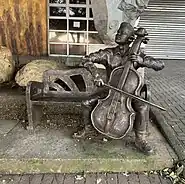
The canton is served by the Municipal School of Integrated Arts (or "EMAI"), which is located in the canton’s head city of Santa Ana. It is funded by the canton’s local government.[25] The school was founded upon the approval of a proposal made by Dr. Jorge Luis Acevedo in 1998.[18] The school also has an art gallery (The "EMAI Art Gallery", also created in 1998),[18] a cafe, as-well as several sculptures and statues along the school’s entrance. The school holds several events, including a Baroque music festival, and the "Luz de Luna Verano" ( "Summer Moonlight" ) festival, which is based on tradicional Costa Rican culture.[26]
Symbols
Flag

Adopted by the municipal council of the canton on 22 April 1987,[27] the flag consists of three symetrical horizontal stripes. The top most green stripe represents the canton's nature and fields, the middle yellow stripe represents the sun (as the canton and the valley it resides in has been nicknamed "The Valley of the Sun"), and the lower most pink stripe representing the colour of the flowers of the Roble Sabana, another of the canton's symbols.[1][27]
Seal

Also referred to as the canton's coat of arms,[1][27] the seal features a yellow medieval-style turret at the top, with the inside having a Roble Sabana, a valley with a path through it, and a man working with a shovel. The shield is surrounded by two coffee branches.[1][27] The seal was designed in 1971.[27]
Roble de Sabana
.jpg.webp)
The Tabebuia rosea (nicknamed "Roble de Sabana", meaning Savannah Oak) is native to Costa Rica, and can be seen in the country's warm areas.[28] It was declared a symbol of the canton by Santa Ana's Municipal Council in ordinary session n.267 held on June 23, 2015. The tree can also be seen of the canton's seal and flag.[1]
The onion
It is believed that the onion was introduced to the canton in 1915,[9] and soon became a facet of farmers' cultivations, with many subsisting thanks to the crop.[16] By 1970, a total of 200 hectares of onion plantations were seen in the canton. However with the regions urbanisation, that number has dropped to around 50 hectares in modern times. The canton still celebrates an onion fair around March, when the region sees its highest production of the vegetable.[16][29]
Notable people
This is a list of people born or that have lived in Santa Ana.
- Marcia González Aguiluz: Lawyer with an emphasis on environmental law. She was the president of the Citizens' Action Party between 2017 and 2018, as well as former minister of justice and peace under president Carlos Alvarado Quesada.
- María Luisa Ávila Agüero: A Pediatric subspecializing in infectious diseases who was the minister of health under presidents Óscar Arias Sánchez and Laura Chinchilla.
- Michael Umaña: Former football player who played as a defender.
- Carlos Martínez: Football player who currently plays at A.D. San Carlos as a defender.
- Marcial Aguiluz Orellana: A Honduran farmer who would join the Costa Rican legislative assembly on two occasions. He was a rebel figure in the 1948 civil war. He lived and died in the canton.
References
- 1 2 3 4 5 6 "El Cantón". santaana.go.cr (in Spanish). Gobierno local de Santa Ana. Retrieved 8 February 2023.
- ↑ Hernández, Hermógenes (1985). Costa Rica: evolución territorial y principales censos de población 1502 - 1984 (in Spanish) (1 ed.). San José: Editorial Universidad Estatal a Distancia. pp. 164–173. ISBN 9977-64-243-5. Retrieved 5 October 2020.
- 1 2 "Declara oficial para efectos administrativos, la aprobación de la División Territorial Administrativa de la República N°41548-MGP". Sistema Costarricense de Información Jurídica (in Spanish). 19 March 2019. Retrieved 26 September 2020.
- 1 2 3 División Territorial Administrativa de la República de Costa Rica (PDF) (in Spanish). Editorial Digital de la Imprenta Nacional. 8 March 2017. ISBN 978-9977-58-477-5.
- ↑ "Santa Ana" (PDF). Bibloteca Virtual en Poblacion, Centroamericano de Poblacion (in Spanish). Instituto de Fomento y Asesoría Municipal. 1985. Retrieved 4 February 2023.
- 1 2 "Atlas de desarrollo humano cantonal, 2021". unpd.org (in Spanish). United Nations Development Programme Costa Rica. Retrieved 4 February 2023.
- 1 2 3 4 5 6 7 8 9 10 11 12 13 "SANTA ANA CANTÓN 1- 09". Ifam.go.cr (in Spanish). Instituto de Fomento y Asesoria Municipal. Retrieved 26 January 2023.
- ↑ Aguilar, Ana Yancy. "Conozca el origen del nombre del cantón de Santa Ana" (in Spanish). Amprensa. Retrieved 26 January 2023.
- 1 2 3 4 5 6 7 8 9 10 11 12 13 14 15 16 17 18 19 20 21 22 23 24 25 26 "Santa Ana history: Was this Spain's first town in the Central Valley?". The Tico Times. July 7, 2016. Retrieved 1 February 2023.
- ↑ "Búsqueda de Sitios Arqueológicos". origenes.museocostarica.go.cr (in Spanish). Museo Nacional de Costa Rica. Retrieved 5 September 2023.
- 1 2 3 4 5 Nelson, H. D (1983). Costa Rica, a country study / Foreign Area Studies, the American University ; edited by Harold D. Nelson (2nd ed.). Washington D.C: Headquarters, Dept. of the Army. p. 9-10. Retrieved 19 September 2023.
- 1 2 "Museo Histórico Agrícola". fundazoo.org (in Spanish). Fundación Pro Zoológicos, (Fundazoo). 3 June 2021. Retrieved 14 December 2023.
- 1 2 "Centro de Conservación Santa Ana". fundazoo.org (in Spanish). Fundación Pro Zoológicos, (Fundazoo). 3 June 2021. Retrieved 14 December 2023.
- 1 2 "Hace 115 años Santa Ana fue declarado cantón". santaanahoy.com (in Spanish). Santa Ana Hoy. Retrieved 8 September 2023.
- ↑ "Historia". parroquiasantaana-cr.org (in Spanish). Parroquia de Santa Ana. Retrieved 20 October 2023.
- 1 2 3 "Pueblo Cebollero". parroquiasantaana-cr.org (in Spanish). Parroquia de Santa Ana. Retrieved 8 September 2023.
- ↑ "Nuestra Institución". csa.ed.cr (in Spanish). Colegio de Santa Ana. Retrieved 30 October 2023.
- 1 2 3 "10° Aniversario Fundación EMAI". emaicr.com (in Spanish). Escuela Municipal de Artes Integradas, EMAI. Retrieved 23 November 2023.
- ↑ "Historia". emaicr.com. Escuela Municipal de Artes Integradas, EMAI. Retrieved 4 December 2023.
- ↑ "Área en kilómetros cuadrados, según provincia, cantón y distrito administrativo". Instituto Nacional de Estadística y Censos (in Spanish). Retrieved 26 September 2020.
- ↑ "Santa Ana". City Population. 4 July 2020. Retrieved 16 October 2020.
- ↑ "Instituto Nacional de Estadística y Censos" (in Spanish).
- ↑ "Sistema de Consulta de a Bases de Datos Estadísticas". Centro Centroamericano de Población (in Spanish).
- ↑ "Censo. 2011. Población total por zona y sexo, según provincia, cantón y distrito". Instituto Nacional de Estadística y Censos (in Spanish). Retrieved 26 September 2020.
- ↑ "¿Quiénes somos?". emaicr.com (in Spanish). Escuela Municipal de Artes Integradas, EMAI. Retrieved 4 December 2023.
- ↑ "Proyección de la Escuela Municipal de Artes Integradas - 2009". emaicr.com (in Spanish). Escuela Municipal de Artes Integradas, EMAI. Retrieved 5 December 2023.
- 1 2 3 4 5 "Santa Ana (San Jose, Costa Rica)". crwflags.com. Flags of the World. Retrieved 10 October 2023.
- ↑ "Roble Sabana". costaricagardens.com (in Spanish). Costa Rica Gardens. Retrieved 9 February 2023.
- ↑ "Breve reseña" (PDF). simposiointernacionalarteytradicion.files.wordpress.com. Asociación Escultórica Valle del Sol (AEVaS). Retrieved 17 October 2023.